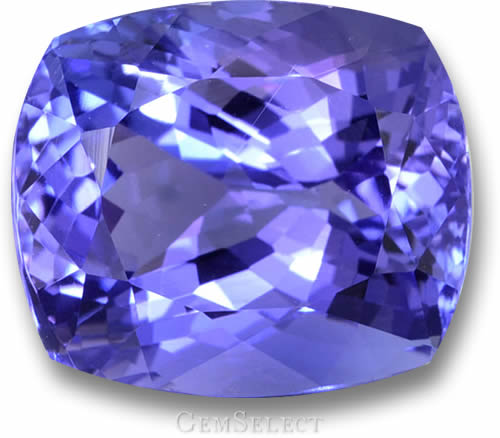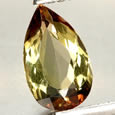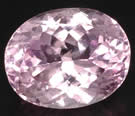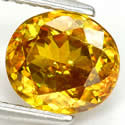Pleochroic gemstones
Pleochroic gemstones captivate the eye and imagination with their remarkable ability to display multiple colors when viewed from different angles, a phenomenon that sets them apart in the world of mineral treasures.

Natural Tanzanite Gemstone
Pleochroism occurs due to the varying absorption of light rays in doubly refractive crystals. Therefore, gemstones that are singly refractive, such as diamond, spinel, and garnet, do not display pleochroism. Additionally, pleochroism is not observed in amorphous gems, opaque stones, colorless stones, and the majority of translucent gems that lack transparency.
 Pleochroism occurs in varying degrees and is termed weak, distinct or strong. Among the gems that are strongly pleochroic are andalusite, iolite, kyanite, kunzite, sphene and tanzanite. Some pleochroic gems are said to be dichroic - displaying two different colors; kunzite is an example. Others are said to be trichroic, such as andalusite. Pleochroism occurs in varying degrees and is termed weak, distinct or strong. Among the gems that are strongly pleochroic are andalusite, iolite, kyanite, kunzite, sphene and tanzanite. Some pleochroic gems are said to be dichroic - displaying two different colors; kunzite is an example. Others are said to be trichroic, such as andalusite.
Andalusite displays shades of yellow, olive and reddish-brown, depending on the orientation of the crystal. The pleochroic effect can be enhanced by specific orientation and cut. Cuts with a long axis such as oval, pear, marquis and emerald cut tend to show one color near the center and a second, usually darker color, near the ends. Square and round cuts usually blend the colors into a mosaic.
 Iolite was once known as water sapphire for its distinctive sapphire-like hue. But when viewed from different angles, iolite can appear clear as water, or a grayish-yellow. When cut correctly, usually in an emerald or step cut, it will display a lovely violet blue with a velvety softness. Iolite was once known as water sapphire for its distinctive sapphire-like hue. But when viewed from different angles, iolite can appear clear as water, or a grayish-yellow. When cut correctly, usually in an emerald or step cut, it will display a lovely violet blue with a velvety softness.
Kunzite displays two colors rather than three. Its pleochroism is quite pronounced and can easily be seen, even in still photographs. The green form of spodumene; hiddenite, displays a similar dichroism.
 While some gems, such as kyanite, display different depths of color (light-blue and dark-blue), sphene is an example of a gemstone with dramatic pleochroism. Sphene displays colorless, green-yellow and reddish hues depending on the viewing angle. Since sphene has extraordinary dispersion (also known as fire) as well, it can put on quite a dazzling display. While some gems, such as kyanite, display different depths of color (light-blue and dark-blue), sphene is an example of a gemstone with dramatic pleochroism. Sphene displays colorless, green-yellow and reddish hues depending on the viewing angle. Since sphene has extraordinary dispersion (also known as fire) as well, it can put on quite a dazzling display.
Tanzanite is a strongly pleochroic gem, but you will rarely see its pleochroism. That's because tanzanite is usually heated to produce the familiar violet-blue color. In its natural state, tanzanite can display purple and blue with some brown or yellow tones. Heat treatment removes the yellowish and brown tints and enhances the blue hue.
|
